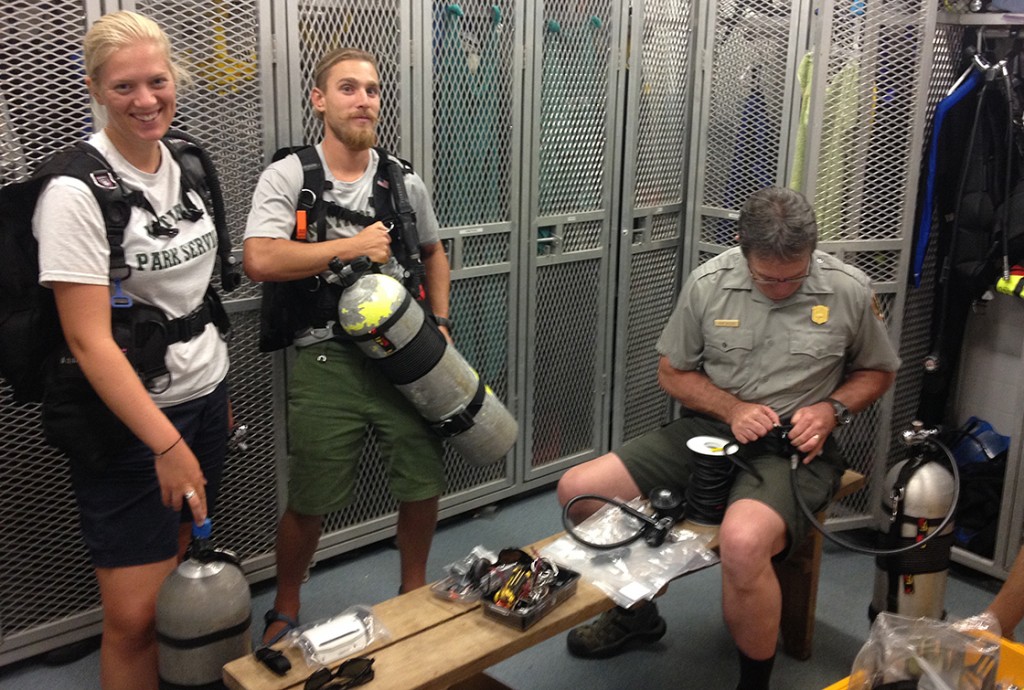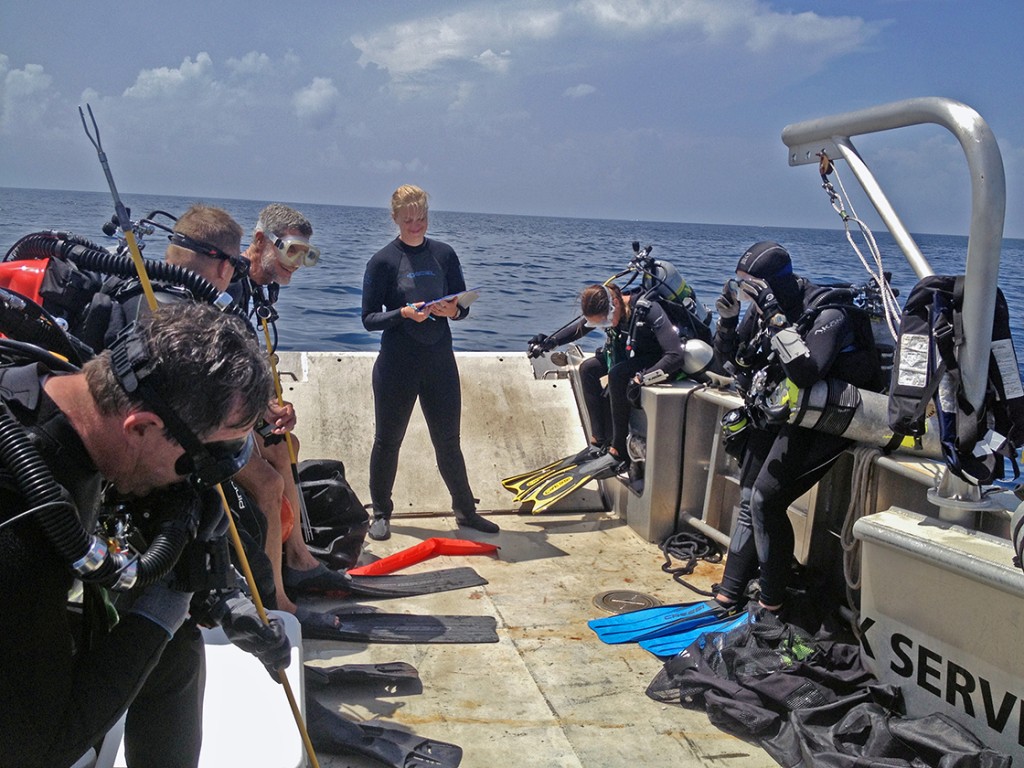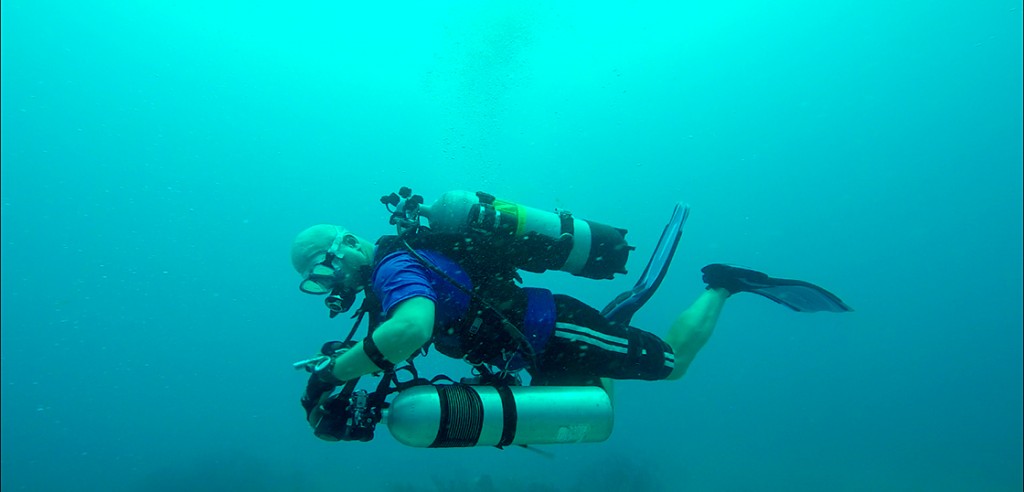There’s one thing I can tell you for sure, Florida and Oregon are definitely on opposite sides of the continent. After leaving the burgeoning summer in the Pacific Northwest, I arrived in south Florida some 20 hours later. There I met up with Brett Seymour, Deputy Chief of the SRC, and together we headed to Biscayne National Park at the southern end of Biscayne Bay.
A little known Park, BISC covers 172, 971 acres of Biscayne Bay. While the eastern most edge of this mostly marine park is delineated by a depth contour of 60ft, the majority of the Park is westward of the outlying keys, which presents some very interesting navigation hazards. After spending 2 weeks in American Samoa, and another on Oahu, you’d think that I would be accustomed to summertime weather in the tropics. But I guess a week on the Channel Islands and another at Crater Lake spoiled me. My head was positively spinning when I got to BISC. Mangroves border the water’s edge, while cicadas drown out all but the loudest boats. But I didn’t have much time to soak in the tropical climate; we had to work to do.

We were luck to have Steve Sellers, the NPS’s DSO, provide the instruction for the deco class. Maintaining buoyancy midwater during a long safety stop while keeping control of a surface marker buoy can be pretty tiring after a long dive. Steve showed us the proper way to “hang on a bag” so that you’re keeping tension on the SMB without having it pull you up, or you pulling it down.
BISC has one of the most ambitious diving operations in the Park Service. Divers are usually in the water almost every day, working on a variety of interesting projects. Biscayne Bay is home to a wide array of shipwrecks and other cultural resources dating back several centuries. But the natural resources of the Park are just as interesting. Most people don’t associate the United States with coral reefs, aside from Hawaii of course, but southern Florida is home to prolific coral reefs. However, there are increasing environmental and anthropological pressures threatening the reefs and cultural resources of BISC, and that’s where the Park Service comes in.
To help combat an invasion of lionfish of epic proportions (more on that later) Park Services divers cull these dangerous trespassers with all they’ve got. However, the sneaky fish are found ever deeper, so the park management of BISC had requested some decompression dive training from the NPS National Dive Safety Officer Steve Sellers with support from the NPS Submerged Resources Center Chief and Deputy, Dave Conlin and Brett Seymour.
On my first full day at the Park I was reacquainted with Dave and Steve, after saying goodbye to them in Denver way back at the beginning of all of this. I also met Shelby Moneysmith, BISC’s tireless Park Diving Officer and the southeast region’s Regional Diving Officer. Shelby had requested this course so that some of her divers extend the lionfish management program to deeper depths. Steve would be teaching the course, with Dave and Brett as support staff, and by some good fortune I was able to participate.
Many SCUBA divers pay close attention to their NDL, the no decompression limit. As a function of breathing compressed air at depth, nitrogen gets diffused into the body’s tissues. As we come up from depth, we need to let the nitrogen safely come out of our tissues in order to avoid complications such as decompression sickness. Most divers won’t stay down long enough to require dangerous amounts of nitrogen, and can theoretically ascend to the surface (safely!) at any time during the dive. Though safety stops (hanging out at 15ft for 3 minutes) should always be made.
With decompression diving, all you’re doing is extending your dive time past the NDL. Essentially you dive deeper, and longer, and then have to make more than one safety stop. I won’t bore you with the details, but just for example after a 120ft dive you might stop at 50ft for 1 min, 40ft for 2 min, 30ft for 4 min and 15ft for 25 min. Of course, that’s all hypothetical. Notice that last stop though, 25 min at 15ft! I’ve had working dives with less bottom time than that! Of course, with decompression diving you’re extending your overall dive time, so you need to plan on bringing a lot more breathing gas than usual. But that’s all part of the training. Are you still with me? Good.

Before any deco dive you need to calculate your respiratory minute volume (RMV), how much gas you breath at depth. From that calculation you can adjust how much gas you’ll need to bring with you to execute a safe dive.
So, day 2 at BISC and we’ve started off our deco training with a nice long classroom session. It had been way too long since I’ve gotten such formal SCUBA instruction! Steve did an excellent job walking us through decompression theory, gas planning and management, contingency planning (safety first!) and safe boating practices. In places like BISC, with a reef on the bottom and nothing but water to the surface, all of those decompression stops are usually done floating in the water column, so you have a lot of different factors to consider.
- After a day in the classroom we spent the afternoon prepping our equipment. Having never used a bailout bottle before, it took some time to configure all of my gear.
- Before a dive begins everybody needs to record the pressure in their tanks, secure any loose gear and wait for the boat operator to give the signal, “dive, dive, dive!”
- When diving with such large tanks it’s important to maintain trim. Which is easier said than done with a 125cf tank on your back and an 80cf tank on your side. During training we figured out which configuration worked best.

Shelby Moneysmith, BISC’s tireless PDO (and the region’s RDO) participated in the deco training with us. After we finished training we put our skills to the test, hunting lionfish on a wreck in about 130ft of water.
After a day in the classroom it was time to hit the water. On day 1 of our in-water training we planned on doing two dives each; we were not planning on going into deco. We were tested on our gear handling and gas consumption at depth first. Typically, the bigger the tank the more gas you have to breath and the longer you can dive. We planned on diving with steel 125cfs, that is 125 cubic feet of air. Not only that, but we also each had an aluminum 80 clipped to our sides. With a tank of “back gas” at 125cf, and “off board” tanks at 80cf, we each had a total of 205cf of air to breath! That’s more than 3x what I would normally dive with! Talk about contingency planning. Also, our back gas tanks had H-valves instead of the typical valves you see on a SCUBA tank. The H-valves have to independent regulators connected to them (instead of just 1). That way, if you have a leak on either regulator you can isolate it and save your gas.

When planning a decompression dive, you always need a contingency in case of emergency. Typically you use an H-valve (instead of a regular yoke) with two regulators on your tank (instead of one), that way you can always isolate a regulator if you have an issue. In this picture Mike, one of BISC’s biotechs, practices isolating a regulator. This picture was taken at about 120ft.
Day 1 went smoothly, so for Day 2 we planned on executing an actually deco dive. Here we go. Steve would be leading the dive, with either Brett or Dave accompanying us on their rebreathers (more on that later). We lined the gunnels of our dive boat and waited for the skipper’s call. Because BISC sits at the edge of the Gulf Stream, the currents can absolutely rip through a dive site. You need to be ready to coordinate a drop and get to the bottom as a group as quickly as possible. Head the skippers call; all diver’s ready? dive, dive, dive! We backwards rolled over the rail, and hit the water. Immediately the ache from the heavy tanks is relieved as the buoyancy of seawater does its thing. Our slung 80s moved into position under our flanks, and we dropped into the blue.

It took some getting used to, but after a couple of dives I hardly noticed the tank on my side. Notice the pole spear dangling from my right shoulder; on this day we hunted lionfish on a wreck in about 130ft of water.
What does a coral reef look like at 130ft you ask? Just like it does at 45 or 60ft, except the light is a little dimmer, you’ve got a lot more water above you. What’s it like going into deco you ask? It’s no different than any other dive. Your dive computer starts to freak out at you, but of course we had everything planned. It was a remarkably uneventful dive. We practiced our skills, and took a quick tour, nothing out of the ordinary. Your dive team really needs to be on point for this kind of work, so when we reached our time limit we ascended as a team to your first stop . Then to our next, and finally to our last and longest. It’s strange having a “soft ceiling” above you for the duration of a dive. The water was very clear; you can plainly see the surface from depth. But you can’t go up, not until you’re cleared from each depth-stop. With our surface maker buoys attached to our hand-held reels, we patiently waited for our tissues to off-gas. Floating mid-water over a reef 100ft below you, carried helplessly in a current, can be a little nerve wracking. But of course we stayed as a group, floating together and occasionally signaling to one another. Nothing makes you hungrier than watching your computer count down a 25min stop after an already hour-long dive. I’m bringing a candy bar next time.

Lionfish have no predators in the Atlantic or Caribbean and don’t live long enough to learn to avoid divers. Shelby nabbed this big lionfish under the Bluefire wreck.
Day 3 we repeated the same skills, only this time we brought along pole spears. After manipulating our H-valves, and passing around our off board cylinders, we proceeded to scour the reef, looking for our not-so-elusive prey. After all, the whole point of this training was to allow the participating divers to safely hunt lionfish at deeper spots. Swimming around with a hung tank on your back, a normal sized but still large tank, clipped to your side and a spear in hand isn’t easy. But it was certainly a very good training exercise.

A lionfish may present a danger to any fish smaller than it, but they are also dangerous to anything trying to eat it as well. Armed with multiple sharp and venous spines, they must be properly handed to avoid injury. Terry, a long time volunteer with BISC, has helped cull the lionfish outbreak in the Park for years.
After 4 days of deco training, Steve gave Shelby and the BISC divers the green light to continue their operations at deeper depths. Watch out lionfish. But the SRC wasn’t content to sit by and watch, they had their own dives to do. Because of the SRC’s mandate to support underwater resources in parks at a wide range of depths and environments they use closed circuit rebreathers to extend their bottom times, decrease their decompression times, and most importantly accomplish both in the safest manner possible. Normal SCUBA diving is considered open circuit; you take a breath off of your regulator, and exhale it out into the water (hence all the bubbles). Rebreathers recirculate your exhalation, remove the excess CO2 and pump back in oxygen to balance the breathing mixture. No exhalations, no bubbles. Rebreathers look like spaces suites without all the body constriction, and are about as complicated.

Prior to entering the water on a closed-circuit rebreather (CCR), divers must first pre-breath their gas mixture to make sure everything is functioning properly. From left to right: Steve Sellers (the NPS’s DSO), Dave Conlin (the SRC’s Chief) and Brett Seymour (the SRC’s Deputy Chief).
Dave, Brett and Steve wanted to execute some mixed gas decompression dives to maintain proficiency. Their target was 220ft using a special breathing mix called trimix. I won’t bore you with the details again, but in short trimix uses helium to replace a portion of nitrogen in the breathing mix to minimize nitrogen narcosis at depth. In order to get the gas mixtures precise they had to spend hours at the dive locker balancing the gas mixes and filling their rebreather cylinders and off board “bail out” bottles with the special mixture before diving the next day. Though they’ll never admit it, these guys are kind of a big deal.

After coming up from their dive to 220ft, the SRC had plenty of time to decompress. They had to spend over a 30min just at 20ft to decompress safely. Notice the lack of bubbles? CCRs recirculate air back into the mix. From left to right: Dave, Steve, and Brett.
Days 4 and 5 we accompanied the SRC out to their site, where they would make a live drop with a narrow window down to 220-230ft to a wreck site called the Sir Scott. After they came back, some 90 minutes later, it would be our turn to drop down, to much shallower depths of course, and hunt for lionfish. As they worked out their kinks, I was continuously impressed with how humble and nonchalant they were. Refusing help with their rebreathers, off board 80s and 40’s so they knew exactly where everything was in case of emergency, they were more than eager to help us load up with all of our gear.

One thing to consider when planning a deco dive is the amount of time you need to decompress in the water column. Floating midwater can be a little nerve wracking, especially when big toothy things are cruising near by. However, sharks play a vital role in the ocean, and have gotten a bad rap over the years. It was awesome getting to see this 6ft silky shark, even if he got a little too close for comfort.
Steve, Brett and Dave worked through the weekend to help us get comfortable with deco diving, and wasted little time achieving their goals as well. I’d really like to thank them for all of their help. And of course Shelby Moneysmith as well, for being continuously patient and in good spirits no matter what happened. Now that training is over, I can finally get to work with the Resource Management team here at BISC.
Thanks for reading!





Last time I worked at Biscayne (on the Erl King and Alicia) we were much shallower – basically doing deco for the whole dive! I would be happy to help cull lion fish the next time I get out that way.
Congrats, Pike – good job!
unreal, all the things you have to remember! Amazing and stunning, thanks for sharing
great post, Pike. but why the lionfish invasion? did they proliferate because of something we did/are doing? and what do they do that’s so dangerous that we feel we need to cull them? why not just let nature take its course? (sorry if I missed your explanation)
… wait! 20 HOURS to fly cross country??!?